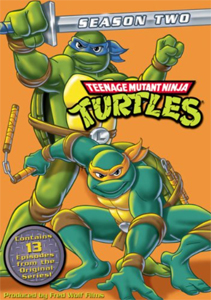After a strong Season 1 and a bland “Eye of Sarnath” arc to start Season 2, episodes 6-13 of “Teenage Mutant Ninja Turtles” Season 2 (1988) is where the show finds its identity. It realizes complex, multi-episode arcs are not in its wheelhouse, and instead settles into standalone episodes built on amusing tropes, the Turtles’ reliable one-note personalities, and unveilings of new characters (action figures) and vehicles.
As a kid, I subconsciously judged the episodes by how many Playmates toys they featured, so I was partial to “Enter: The Fly” (episode 7, written by Michael Reaves and Brynne Stephens) and “Invasion of the Punk Frogs” (8, Reaves). The former introduces the Knucklehead (the hardest-to-find of the early vehicles) and the Turtle Trooper Parachute (the hardest to play with, unless you’re dropping your Turtles out a skyscraper window).
Irma as audience surrogate
All nine episodes are solid, though, and on this viewing I noticed they are tied together by – of all people – Irma! April’s coworker and bestie (voiced by Jennifer Darling, and much less irksome than her reputation) is obsessed with meeting Mr. Right in half her scenes with April, obsessed with meeting the Turtles in the other half. Although one could argue that Irma has a crush on the Turtles, I think it’s a case of celebrity worship. Therefore, this cartoon passes the Bechdel Test (two female characters talk about something other than a man) surprisingly quickly.

“Teenage Mutant Ninja Turtles” Season 2, episodes 6-13 (1988)
Syndicated
Episodes: “The Case of the Killer Pizzas” (6), “Enter: The Fly” (7), “Invasion of the Punk Frogs” (8), “Splinter No More” (9), “New York’s Shiniest” (10), “Teenagers from Dimension X” (11), “The Catwoman from Channel Six” (12), “Return of the Technodrome” (13)
Producer: Fred Wolf
Writers: Douglas Booth (6), Michael Reaves (7, 8, 9, 11, 13), Brynne Stephens (7, 9), Richard Merwin (10, 12)
Since the cartoon hasn’t introduced Casey Jones at this point, the April-Irma friendship nicely takes its place. Likely the writers wanted to stay away from romances — aside from Irma’s longing for a date, and occasionally bizarre successes, like with the robot REX-1 in the light “RoboCop” parody “New York’s Shiniest” (10, Richard Merwin). Even when Casey is introduced in Season 3, he’s not a love interest for April.
Michaelangelo’s and Kala’s mutual crush is a cute gag in “Teenagers from Dimension X” (11, Reaves), making him the first Turtle to have a love interest. Leo would later crush on Lotus Blossom and Raph on Mona Lisa. Donatello, despite sounding like Woody Allen via Barry Gordon’s voice work, is the least romantically distracted. Mikey and Kala have photos of each other, and since we didn’t see them exchange pics in Season 1, perhaps there’s a lost episode in between (maybe something for IDW’s “Saturday Morning Adventures” comic to explore?).

Continuity oddities and plot holes have been with the cartoon from the start, in Season 1 due to rushed production, in the “Eye of Sarnath” arc due to sloppy writing. In the back half of Season 2, these things are now part of the fabric. In “The Catwoman from Channel Six” (12, Merwin), April trans-mutates with a cat, and despite no comment (let alone evidence) from anyone that the mutation will wear off with time, that is simply what happens, apparently.
I’m sure the randomly introduced Dimension X tech is purposely part of the vibe, though. This plays a big role in “Enter: The Fly.” Krang intends to kill Baxter in a disintegrator (but it malfunctions and he trans-mutates with a fly, as per 1986’s “The Fly” but with cellular stability – but not mental stability). Then a randomly introduced pair of electrodes zap Baxter a second forward in time.
Shredder and his goons
Baxter is Shredder’s human lackey for the memorable “Aliens”/“Gremlins” riff “The Case of the Killer Pizzas” (6, Douglas Booth), featuring Pizza Monsters that can burn through walls and grow when exposed to water. Baxter turns into a fly one episode later – with voice actor Pat Fraley nailing it (also a shout out to always great April actress Renae Jacobs, who later gets to be a hissing catwoman).
With Baxter set aside, the new structure is established: Shredder, Bebop and Rocksteady try and fail to kill the Turtles with various techno-schemes. The reason why Krang doesn’t bring the Technodrome back to Earth — until “Return of the Technodrome” (13, Reaves) – varies by the writer’s whim. It could be a lack of power to open a portal, or Krang’s desire that the Turtles be eliminated first, or Krang’s amusement over watching Shredder and his goons fail.
The animation is inconsistent – it becomes outright bad in “Enter: The Fly” when a less skilled team animates the Turtles in gumby-like form. You can count on one instance of Turtle-to-voice-actor mismatch per episode, like they are in-jokes. But the writing stabilizes, largely because Reaves pens so many episodes. He cares more about plot coherence and logic than the other scripters.
Aside from the finale that brings back Season 1’s epic “Star Wars”-ian vibe (with Splinter and Shredder meeting on a Technodrome catwalk amid grand music), the standout is “Splinter No More” (9, Reaves and Stephens). Splinter is depressed so Don works up a retro-mutagen spray to turn him human. It leads to a reverse “Teen Wolf” and comments on how humans are as nasty to their fellow common man (Yoshi is immediately surrounded by thugs who aim to kill and rob him) as they are to freaks.
Reaves builds up a sense of foreboding as Shredder (with B&R humorously “disguised” in sweatsuits) researches in the library and learns about an underground temple wherein a dimensional portal can be opened by magic. This leads to the show’s first Lovecraftian creature homage.
Logic holes and other strangeness
“Teenagers from Dimension X” is notable for nice background cels of a rundown part of town that “even a SWAT team would avoid,” according to Raph. The Neutrinos are best taken in small doses, granted, but indeed that’s what the show has given us.
The Punk Frogs, on the other hand, I would’ve liked to see more of – even though I can’t tell one from the next. They appear in only three more episodes. I like the quartet’s good-natured attitudes, and how they see through Shredder’s lie that the Turtles are evil (he also tries this disinformation tactic on Fly Baxter and Catwoman April).
It bugged me that Playmates didn’t follow up 1989’s Genghis Frog with Napolean Bonafrog until a whole year later (an eon in Kid Time) and that Atilla the Frog and Rasputin the Mad Frog never got Playmates figures. (NECA recently rectified that, but we’re now in an era where action figures cost $40 instead of $4. But it’s fun to look at the pictures.)
The “TMNT” toon knows its formula, with the Turtle Blimp (introduced in Season 1) becoming an effective trope for having the Turtles get around and spy on Shredder. Where they dock the blimp is utterly unexplained, as are many other things. Another example: Shredder zips down to Florida to acquire the Punk Frogs and quickly gets back to NYC, but his transportation goes unmentioned. Meanwhile, the writers give him a techno-magic device solely for the purpose of changing clothes!
As a kid, this stuff never bothered me consciously, and as an adult, it’s amusing. Reaves writes or co-writes five of these eight episodes and gives them some grounding, but not too much grounding. “TMNT” is still a fast-paced, quip-filled land of mutants and wacky tech.

